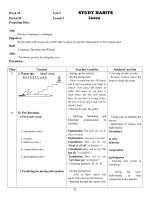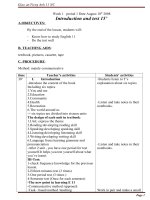giao an 11 nc u 1- u 4
Bạn đang xem bản rút gọn của tài liệu. Xem và tải ngay bản đầy đủ của tài liệu tại đây (84.46 KB, 4 trang )
LESSON PLAN
Unit Six
Population
Lessons N
0
1-2 Reading
Outcomes - By the end of the lesson, the student are able to scan reading for specific information
- By the end of the lesson, the student are able to complete a summary.
Type of lesson
- Skill-based (reading)
Key Vocabulary - density - immigrant - populous - approximately
- implement - account for
Key structures - China ‘s population growth rate has decreased in past year.
- Its population is approximately 1.3 billion, which is almost 22% of the word
Population.
Anticipated problems
- Some students seem not willing to speak and share ideas.
Material - Textbook - Handouts
- Chalk and board - Pictures
Stage /
Timing
Procedure Aims Focus Material
1.
Warm-
up &
lead-in
(10-15’)
2.Pre-
Readin
g
(8 – 10’)
Game: Quizzes and Riddles
- Divide the class into two groups.
- Read the question and ask the group to give answers.
- With one correct answers, the group scores one point. The group with
more point wins the game.
- Have SS start the game.
- Keep a running total of points for each group on the board.
- Declare the winner.
Here are the questions for the quiz:
1. What is the big country situated to north of Vietnam?
2. What is the capital city in Latin America which has the same name
as its country?
3. Magic numbers: Ask SS to pick a certain number between 2 and
9. Tell them to multiply that number by 9. Next, ask them to add
the two digits of the result. Ask them to subtract 2.5 from this
number and give the result a unit of ‘billion’. What is the final
result?
4. It’s a compound adjective, formed by the opposite of ‘under’ and a
word that means ‘having too many together at a place’.
Expected: 1. China 2. Mexico City 3. 6.5 billion 4.overcrowded
-Ask SS if the words and numbers in the quiz remind them of anything. If
so, what it is. (Expected: population)
(In case SS can’t get it. Ask them what is special about the number 6.5
billion; what is special about China in the world; what is special about
Mexico City in comparison with most other cities in the world; or what the
adjective ‘overcrowded’ refers to.)
Transition: - Yes, and that’s the topic of unit 6. Now look at the picture
on page 77. what message can you ‘read’ from it?
Expected: There are too many people and our natural resources are not
enough for all ( or something similar.)
-Write down on the board: Unit 6 Population Trend in China
Teaching Vocabulary
- Ask SS to complete the sentences in Task b, page.78 and check the
meanings of the phrases given.
- Elicit meaning of other words or give explanations yourself.
. Approximately ( adv.) = almost exactly ( xấp xỉ)
. density (n.) = quality of being crowded together in great numbers(tình
trạng đông đúc; mật độ dân cư)
dense (a.) = dày đặc; đông đúc
. implement (v.) = carry out; put into effect (thực hiện)
- To
create
Interest,
energise
SS and
challenge
them with
some
general
knowledge
- To
engage
SS, and
introduce
the topic
- To
provide
SS with
some
language
to help
them
understan
d
Group
T-class
T-class
T-class
T-class
- Handout
-Chalk &
board
-Textbook
- Chalk &
board
- Chalk &
board
(5 -7’)
3.
While-
reading
(15-18’)
(9 – 10’)
(10-12’)
4. Post-
reading
(15–17’)
.account for (v.) = take up; be the explanation of sth
( giải thích cho…; chiếm…)
. immigrant (n.) =person who has come to live
Permanently in a foreign country ( người nhập cư)
.populous (a.) person having a large population
(đông đúc dân cư)
. record speed (n.) highest speed ( tốc độ kỷ lục)
- Read the words one by one and ask SS to repeat.
Checking Vocabulary: Slap the board
- Write the words just learned randomly on the board.
- Divide the class into two group, A and B.
- Ask 5 student from each group to stand tin a line in the front.
- Read the explanations or Vietnamese equivalents of the words and ask
the student from the lines to run and slap on the correct word.
- The student who slaps first on the correct word earns their group one
point. The group with more points will win the game.
Activity 1: True – False Statements (Task a, p.80)
- Ask SS to read the text and the statements about the population in
China and decide if the statements are true or false.
- Tell SS to compare answers with a partner.
- Call on SS read the sentences aloud and say their choices. Ask SS to
Give explanations for false sentences.
- Check with the whole class.
Activity 2: Which charts or graphs? (Task b, p.80 - 81)
- Tell SS to read the charts and graphs about the population trend in
China and choose the one that illustrates accurate facts in each case.
- Ask SS to work with a partner and compare answers.
- Go over the answers with the class
Activity 3: Completing the summary
- Put SS into pairs and give out handouts of a gapped summary of the
text about China’s population trend.
This is the summary for the handout:
- Tell SS to read and complete the summary with the suitable information
Tell SS they can refer to the text if necessary.
- Go over the answers with the class.
Expected answers: 1. populous 2. 22% 3. density 4. birth
control 5. fell / decreased / declined 6. 35 7. population
growth rate
8. 90% 9. rapid increase 10. growth
- To help
enrich SS
knowledge
of vocab.
- To
practice
pronuncia-
tion
- To review
what just
learned
- To
develop
scanning
skill
- To have
SS practise
reading
graphs
- For SS to
practise
summaries-
ing the text
and get
main idea
- To allow
SS to
express
T-class
Groups
T-class
Indivi-
duals
Pairs
SS-SS
T-class
Indivi-
duals
Pairs
T-class
T-class
Groups
- Chalk &
board
- Chalk &
board
-Textbook
-Textbook
-Handouts
-Textbook
-Textbook
China, the most (1) …………..country in the world, accounts for
nearly (2) …………… of the world population. The population
(3)…………… is extremely high in Shanghai which reaches over
Two thousand people per square kilometer.
Thanks to the implementation of (4)……………….. programmes, the
population growth rate in China (5)……………….. Considerably from
25.83% to 0.58% in (6)……………. Years (1970 -2005).
However, the (7) ……………. in Shenzhen is in the increase.
Shenzhen has a population of 7 million, (8)……………… of which
Are immigrants from all over the country. The city’s (9)………………
in population partly contributes to its rapid (10)………………..
5.
Home-
work
(1’)
Discussion
- Arrange SS to work in small groups.
- Ask them to do part 2. Task a, p.78, putting the phrases in the correct
columns of possible causes and consequences.
- Then ask SS to tick ( ) the causes and consequences that are true
for Vietnam.
- Check with the class.
- Then tell the groups to discuss the topic on what should be included in
the population education programme in Vietnamese high schools.
- Go around to monitor and give help if necessary.
- Call on SS to report about their group’ discussion.
- Give feedback and comments.
Sentence Building
- Tell SS to make meaningful sentences about China from the cues
given.
1. populous country / world/ be / China/ account / almost 22%/ world
population.
2. Although / China’s population / still increase / population growth rate/
decrease greatly / past years.
Expected answer:
1. The most populous country in the world is China, which accounts for
almost 22% of the world population.
2. Although China’s population is still increasing, its population growth
rate has decreased greatly in the past year.
themselves
and share
ideas
-Speaking
as an
integrated
skill
- To
provide
SS with
Some
structure
practise
based on
what they
have
learned
T-class
SS-SS
T-class
Indivi-
duals
- Chalk &
board









